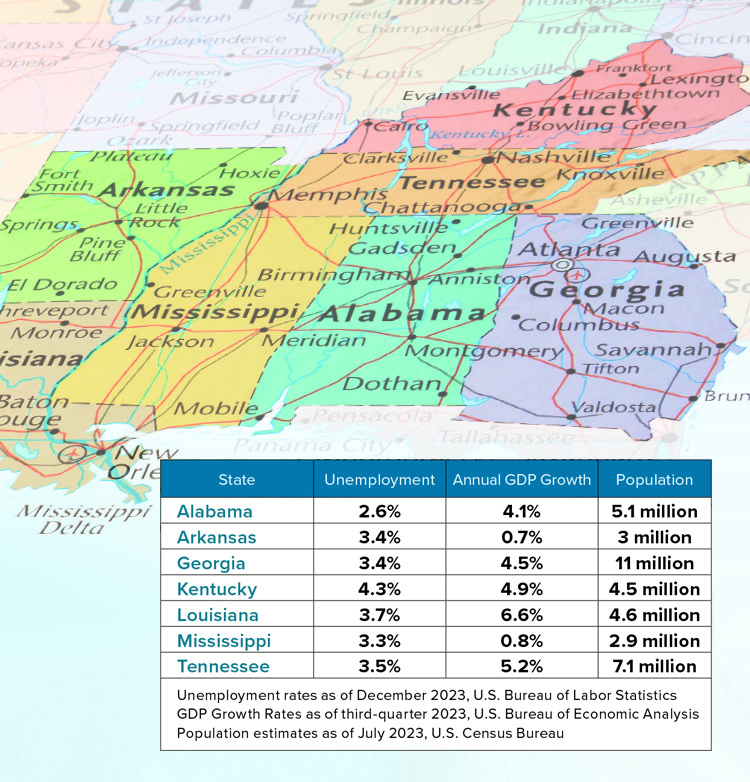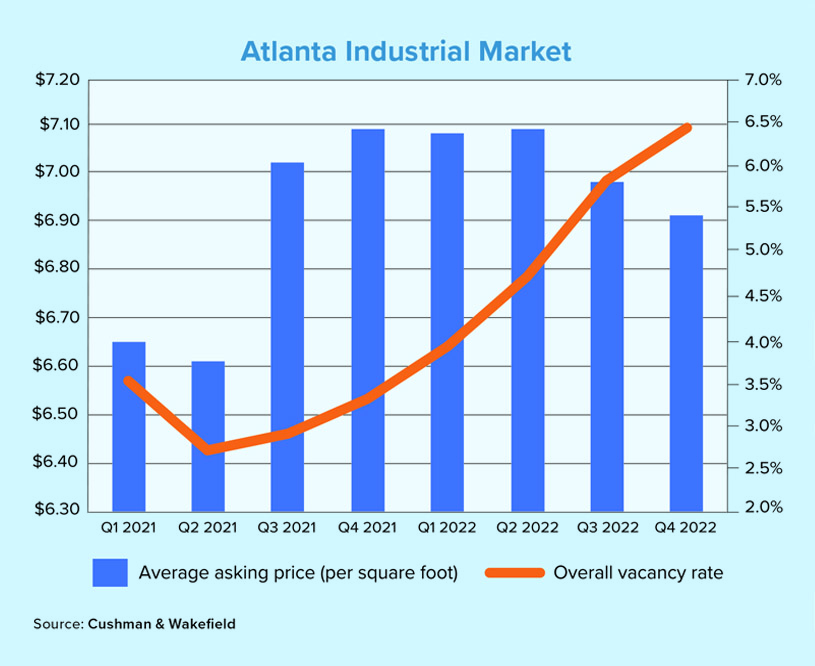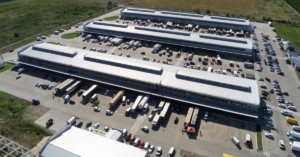Statistics for the Southeast Region of the United States paint a divergent economic picture. This area — which includes Alabama, Arkansas, Georgia, Kentucky, Louisiana, Mississippi and Tennessee — has some of the nation’s fastest- and slowest-growing state economies.
The area’s fastest-growing economy, between the second quarter and third quarter of 2023, was Louisiana. The Pelican State saw its economy jump by an annual rate of 6.6% during the quarter, placing it among the nation’s top-five fastest-growing states.
Louisiana’s economic growth can be attributed to many factors, including $25 billion in capital investments in 2023 alone. Part of that money went to expansion of the state’s economically crucial energy sector, which includes oil and gas interests, as well as alternative energy sources, such as hydrogen, solar, wind and alternative fuels. State officials estimate that 2023’s new investments could result in 11,500 new jobs. Louisiana’s manufacturing sector also employs about 138,000 workers and generates more than $40 billion in total output.
The second-fastest growing economy in this region was Tennessee, which enjoyed a 5.2% growth rate during the same period. The Volunteer State’s economic outlook got a boost last year from an influx of more than 77,500 people between July 2022 and July 2023, according to the U.S. Census Bureau. The population boom has led to major increases in business formations, jobs and home building. Like many of the states in this region, Tennessee has a large automotive industry. It is home to more than 900 auto suppliers and has operations for automotive manufacturers, such as Ford, General Motors, Nissan and Volkswagen. Nearly 143,000 workers are employed in the automotive sector.

Kentucky came in third with a growth rate of 4.9%. Long known for its coal reserves and mining industry, Kentucky also is a major producer of aluminum, copper and steel. The Logan Aluminum factory in Russellville, Kentucky, for instance, produces more than 2 billion pounds of aluminum annually. The plant supplies the raw materials for nearly half the aluminum cans produced in North America. Reynolds Consumer Products produces its ubiquitous aluminum foil in Louisville.
Georgia was fourth with a growth rate of 4.5%. The Peach State is powered by industries such as manufacturing, automotive, aerospace and food processing. These four areas account for nearly 75% of new jobs and 84% of new investments. Much of that investment goes to the state’s automotive industry, which includes a Kia manufacturing plant and the future home of Hyundai’s $5.5 billion factory to manufacture electric vehicles and batteries. Alabama, which grew by 4.1%, is home to bustling aerospace, agricultural, automotive and bioscience industries. About 47,000 people are employed in the state’s automotive sector, which includes assembly plants for Honda, Hyundai, Mazda and Mercedes Benz.
The two states that grew the slowest were Mississippi, at 0.8%, and Arkansas, at 0.7%. These states suffered, in part, from farm incomes decreasing last year, and slowdowns in the forestry, fishing and hunting industries. ●

Atlanta’s industrial market slowed in 2023 from the torrid pace it had set in the prior five years, when the local market absorbed an average of 41.6 million square feet annually. Last year, Atlanta accounted for 22.8 million square feet of new leasing activity, according to Cushman & Wakefield. New deal volume in the fourth quarter of last year decreased by 16.2% quarter over quarter to 4.2 million square feet. But it still ranked among the top-nine highest markets for volume nationwide.
Despite supply-chain issues and increasing interest rates, Atlanta’s industrial inventory also continued to grow last year, with 31.2 million square feet of new property being delivered. By the end of 2023, however, Cushman & Wakefield reported that only 32.2% of the new inventory had found a lessee. The lower tenant demand and increasing inventory have led to a direct vacancy rate, which excludes subleases, of 5.5%. That number is expected to move higher this year as leasing slows and new properties are delivered during the coming months.
New construction projects completed in Q4 2023 included the Northeast 85 Logistics Center, a 1.2 million-square-foot industrial site along the I-85 North Corridor. Projects under construction include The Cubes at Bridgeport, part of a mega site located along the I-85 South Corridor in the city of Newnan, southwest of Atlanta. The development includes a 1.2 million-square-foot warehouse facility.
What the Locals Say
I would describe our market in the Little Rock area as steady. We don’t anticipate a large downturn, nor do we anticipate a lot of growth. The area where we see the most activity right now is in the medical office area. The State of Arkansas is the city’s largest employer, but the medical community would be next. It is very large here. In the retail area, we are seeing a lot of activity in the restaurant space. That is a hot sector right now. When something comes on the market, it’s leased very quickly.
The industrial sector has been good for us. Amazon has made a big splash here, building two large facilities in the last couple of years. Dollar General and Lowe’s Home Improvement have also made big impacts with distribution centers. Industrial has slowed a little recently. But still, when a property comes to market, there is a lot of activity. The current vacancy rate for industrial in the area is probably in the 3.5% range. So, there’s not a lot of excess warehouse space on the market.
As for office, it’s not as bad as what you read about in the bigger markets. We have a lot of vacancies in the downtown area. But our overall office vacancy rate is at 11%, and most of that is in B- and C-level properties. It’s a tenant’s market right now. So, it’s challenging to keep the tenants you’ve got at the rent rates that you have. The situation is difficult, but I wouldn’t anticipate we are going to go through Armageddon like you read about.

President
Kelley Commercial Partners
Sources: Cushman & Wakefield, Forbes, Discover Arkansas, Georgia Department of Economic Development, Georgia.gov, Georgia Power, MSN.com, Mississippi Development Authority, Mississippi Economic Council, Opportunity Louisiana.gov, Select Georgia, Team Kentucky Cabinet for Economic Development, Tennessee Department of Economic & Community Development, The Associated Press, The University of Tennessee, Knoxville, U.S. Department of Agriculture, WAFB9






